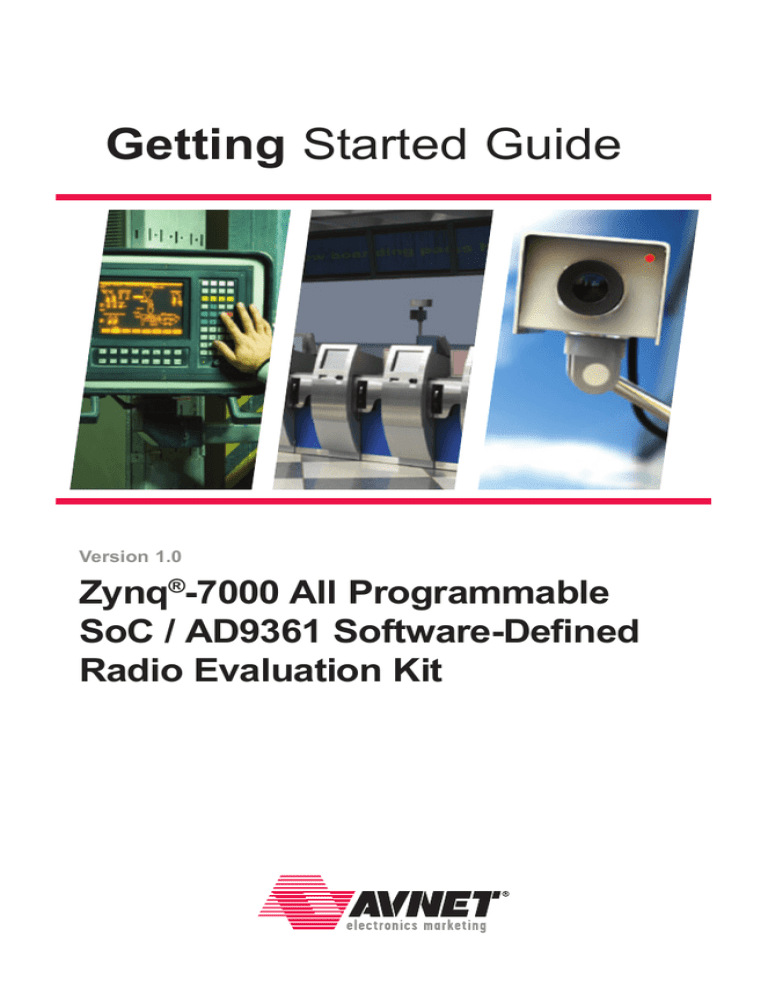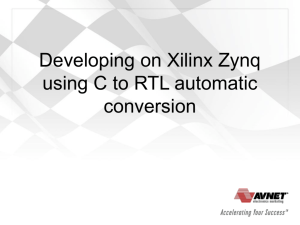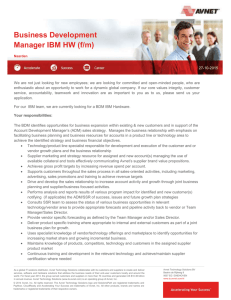
Getting Started Guide
Version 1.0
Zynq®-7000 All Programmable
SoC / AD9361 Software-Defined
Radio Evaluation Kit
REVISION HISTORY
DATE
VERSION
REVISION
11/07/2013
1.0
Initial Release \ LL
2 Getting Started with the Zynq®-7000 All Programmable SoC / AD9361 Software-Defined Radio Evaluation
Version 1.0
AVNET DESIGN KIT TECHNICAL
SUPPORT FILES AND DOWNLOADS
WEB ACCESS INSTRUCTIONS
Thank you for purchasing an Avnet design kit. The technical support documents associated with this kit,
including the User Guide, Bill of Materials, Schematics, Source Code and Application Notes, are available online.
You, the Customer, can access these documents at any time by visiting Avnet’s Design Resource Center (“DRC”)
at: www.em.avnet.com/drc/support
On your first visit to the DRC, you will be required to site register before you can download the documents. To
get started, select the name of the manufacturer associated with your design kit from the drop down menu. A
complete listing of available design kits will appear. Select the kit you purchased. Scroll to the bottom of the
design kit page to access the support files. Before you download a file, you will be prompted to login. If you are
an existing user, please login. If you are a new user, click on the “Need to sign-up?” text. Please complete the
short registration form. Upon completion, be sure to retain your login and password information for future visits to
Avnet’s DRC. Logging in once, gives you unlimited access to all technical support files and downloads. You will also
have the chance to request e-mail notifications whenever there are updates to your design kit.
LICENSE AGREEMENT
THE AVNET DESIGN KIT (“DESIGN KIT” OR “PRODUCT”) AND ANY SUPPORTING DOCUMENTATION
(“DOCUMENTATION” OR “PRODUCT DOCUMENTATION”) IS SUBJECT TO THIS LICENSE AGREEMENT (“LICENSE”).
USE OF THE PRODUCT OR DOCUMENTATION SIGNIFIES ACCEPTANCE OF THE TERMS AND CONDITIONS OF THIS
LICENSE. THE TERMS OF THIS LICENSE AGREEMENT ARE IN ADDITION TO THE AVNET CUSTOMER TERMS AND
CONDITIONS, WHICH CAN BE VIEWED AT www.em.avnet.com. THE TERMS OF THIS LICENSE AGREEMENT WILL
CONTROL IN THE EVENT OF A CONFLICT.
1. Limited License. Avnet grants You, the Customer, (“You” “Your” or “Customer”) a limited, non-exclusive, nontransferable, license to: (a) use the Product for Your own internal testing, evaluation and design efforts at a
single Customer site; (b) create a single derivative work based on the Product using the same semiconductor
supplier product or product family as used in the Product; and (c) make, use and sell the Product in a single
production unit. No other rights are granted and Avnet and any other Product licensor reserves all rights
not specifically granted in this License Agreement. Except as expressly permitted in this License, neither the
Design Kit, Documentation, nor any portion may be reverse engineered, disassembled, decompiled, sold,
donated, shared, leased, assigned, sublicensed or otherwise transferred by Customer. The term of this
License is in effect until terminated. Customer may terminate this license at any time by destroying the
Product and all copies of the Product Documentation.
2. Changes. Avnet may make changes to the Product or Product Documentation at any time without notice.
Avnet makes no commitment to update or upgrade the Product or Product Documentation and Avnet
reserves the right to discontinue the Product or Product Documentation at any time without notice.
3. Limited Warranty. ALL PRODUCTS AND DOCUMENTATION ARE PROVIDED “AS IS” WITHOUT WARRANTY
OF ANY KIND. AVNET MAKES NO WARRANTIES, EITHER EXPRESS OR IMPLIED, WITH RESPECT TO THE
PRODUCTS AND DOCUMENTATION PROVIDED HEREUNDER. AVNET SPECIFICALLY DISCLAIMS THE IMPLIED
WARRANTIES OF MERCHANTABILITY AND FITNESS FOR A PARTICULAR PURPOSE AND ANY WARRANTY
AGAINST INFRINGEMENT OF ANY INTELLECTUAL PROPERTY RIGHT OF ANY THIRD PARTY WITH REGARD
TO THE PRODUCTS AND DOCUMENTATION.
Version 1.0
Getting Started with the Zynq®-7000 All Programmable SoC / AD9361 Software-Defined Radio Evaluation 3
4. LIMITATIONS OF LIABILITY. CUSTOMER SHALL NOT BE ENTITLED TO AND AVNET WILL NOT LIABLE
FOR ANY INDIRECT, SPECIAL, INCIDENTAL OR CONSEQUENTIAL DAMAGES OF ANY KIND OR NATURE,
INCLUDING, WITHOUT LIMITATION, BUSINESS INTERRUPTION COSTS, LOSS OF PROFIT OR REVENUE,
LOSS OF DATA, PROMOTIONAL OR MANUFACTURING EXPENSES, OVERHEAD, COSTS OR EXPENSES
ASSOCIATED WITH WARRANTY OR INTELLECTUAL PROPERTY INFRINGEMENT CLAIMS, INJURY TO
REPUTATION OR LOSS OF CUSTOMERS, EVEN IF AVNET HAS BEEN ADVISED OF THE POSSIBILITY
OF SUCH DAMAGES. THE PRODUCTS AND DOCUMENTATION ARE NOT DESIGNED, AUTHORIZED OR
WARRANTED TO BE SUITABLE FOR USE IN MEDICAL, MILITARY, AIR CRAFT, SPACE OR LIFE SUPPORT
EQUIPMENT NOR IN APPLICATIONS WHERE FAILURE OR MALFUNCTION OF THE PRODUCTS CAN
REASONABLY BE EXPECTED TO RESULT IN A PERSONAL INJURY, DEATH OR SEVERE PROPERTY
OR ENVIRONMENTAL DAMAGE. INCLUSION OR USE OF PRODUCTS IN SUCH EQUIPMENT OR
APPLICATIONS, WITHOUT PRIOR AUTHORIZATION IN WRITING OF AVNET, IS NOT PERMITTED AND IS
AT CUSTOMER’S OWN RISK. CUSTOMER AGREES TO FULLY INDEMNIFY AVNET FOR ANY DAMAGES
RESULTING FROM SUCH INCLUSION OR USE.
5. LIMITATION OF DAMAGES. CUSTOMER’S RECOVERY FROM AVNET FOR ANY CLAIM SHALL NOT EXCEED
CUSTOMER’S PURCHASE PRICE FOR THE PRODUCT GIVING RISE TO SUCH CLAIM IRRESPECTIVE OF THE
NATURE OF THE CLAIM, WHETHER IN CONTRACT, TORT, WARRANTY, OR OTHERWISE.
6. INDEMNIFICATION. AVNET SHALL NOT BE LIABLE FOR AND CUSTOMER SHALL INDEMNIFY,
DEFEND AND HOLD AVNET HARMLESS FROM ANY CLAIMS BASED ON AVNET’S COMPLIANCE WITH
CUSTOMER’S DESIGNS, SPECIFICATIONS OR INSTRUCTIONS, OR MODIFICATION OF ANY PRODUCT
BY PARTIES OTHER THAN AVNET, OR USE IN COMBINATION WITH OTHER PRODUCTS.
7. U.S. Government Restricted Rights. The Product and Product Documentation are provided with “RESTRICTED
RIGHTS.” If the Product and Product Documentation and related technology or documentation are provided
to or made available to the United States Government, any use, duplication, or disclosure by the United
States Government is subject to restrictions applicable to proprietary commercial computer software as
set forth in FAR 52.227-14 and DFAR 252.227-7013, et seq., its successor and other applicable laws
and regulations. Use of the Product by the United States Government constitutes acknowledgment of the
proprietary rights of Avnet and any third parties. No other governments are authorized to use the Product
without written agreement of Avnet and applicable third parties.
8. Ownership. Licensee acknowledges and agrees that Avnet or Avnet’s licensors are the sole and exclusive
owner of all Intellectual Property Rights in the Licensed Materials, and Licensee shall acquire no right,
title, or interest in the Licensed Materials, other than any rights expressly granted in this Agreement.
9. Intellectual Property. All trademarks, service marks, logos, slogans, domain names and trade names
(collectively “Marks”) are the properties of their respective owners. Avnet disclaims any proprietary
interest in Marks other than its own. Avnet and AV design logos are registered trademarks and service
marks of Avnet, Inc. Avnet’s Marks may be used only with the prior written permission of Avnet, Inc.
10.General. The terms and conditions set forth in the License Agreement or at www.em.avnet.com will
apply notwithstanding any conflicting, contrary or additional terms and conditions in any purchase order,
sales acknowledgement confirmation or other document. If there is any conflict, the terms of this License
Agreement will control. This License may not be assigned by Customer, by operation of law, merger
or otherwise, without the prior written consent of Avnet and any attempted or purported assignment
shall be void. Licensee understands that portions of the Licensed Materials may have been licensed to
Avnet from third parties and that such third parties are intended beneficiaries of the provisions of this
Agreement. In the event any of the provisions of this Agreement are for any reason determined to be void
or unenforceable, the remaining provisions will remain in full effect.This constitutes the entire agreement
between the parties with respect to the use of this Product, and supersedes all prior or contemporaneous
understandings or agreements, written or oral, regarding such subject matter. No waiver or modification
is effective unless agreed to in writing and signed by authorized representatives of both parties. The
obligations, rights, terms and conditions shall be binding on the parties and their respective successors
and assigns. The License Agreement is governed by and construed in accordance with the laws of the State
of Arizona excluding any law or principle, which would apply the law of any other jurisdiction. The United
Nations Convention for the International Sale of Goods shall not apply.
4 Getting Started with the Zynq®-7000 All Programmable SoC / AD9361 Software-Defined Radio Evaluation
Version 1.0
INTRODUCTION
The Zynq®-7000 All Programmable SoC / AD9361 Software-Defined Radio Evaluation Kit is based on the
Avnet ZedBoard™ with Xilinx Zynq-7000 All Programmable (AP) SoC. The kit features the Analog Devices ADFMCOMMS2-EBZ FMC module, with AD9361 integrated RF Agile Transceiver. Tuned to a narrower RF range in
the 2400 – 2500 MHz region, the kit is ideal for the RF engineer seeking optimized system performance meeting
datasheet specifications in a defined range of RF spectrum.
This Getting Started Guide will proceed through the steps to setup the Zynq-7000 AP SoC / AD9361 SoftwareDefined Radio Evaluation Kit and run the out-of-box demonstration.
What’s Inside the Box
• Avnet ZedBoard 7020 baseboard
• Zynq-7000 SoC XC7Z020-CLG484-1
• 512 MB DDR3
• 256 Mb Spansion® Quad-SPI Flash
• Onboard USB-JTAG Programming
• 10/100/1000 Ethernet
• USB OTG 2.0 and USB-UART
• FMC expansion (low pin count)
• Multiple displays (Analog Devices ADV7511 1080p HDMI, 12-bit VGA, 128 x 32 OLED)
• Analog Devices AD-FMCOMMS2-EBZ high-speed analog FMC Module
• Software tunable across wide frequency range (70 MHz to 6.0 GHz)
• Factory-tuned for optimal RF performance at 2400 – 2500 MHz1
• Programmable channel bandwidth at the ADC inputs ranging from <200 kHz to 56 MHz
• RF section bypass for baseband sampling
• Phase and frequency synchronization on both transmit and receive paths
• Powered from single FMC connector
• Supports MIMO radio, with less than 1 sample sync on both ADC and DAC
• Includes schematics, layout, BOM, HDL, Linux drivers and application software
• Supports add on cards for spectrum specific designs (PA, LNA, etc.)
• 8 GB SD card,factory-programmed
• FAT32 partition: bootloader, devicetree blob and kernel image for system boot to UBUNTU Linux
• EXT4 partition Linaro Ubuntu ARM root file system, Analog Devices IIO Oscilloscope
• Four Pulse 4G LTE blade antennas, SMA mount
• Micro USB cable
• USB dongle (male micro-B to female standard-A)
• Xilinx Vivado® Design Edition (device locked to XC7Z020)
• Documentation
• Getting Started with the Zynq-7000 AP SoC / AD9361 Software-Defined Radio Evaluation Kit
Getting Started with the Zynq-7000 AP SoC / AD9361 Software-Defined Radio Evaluation Kit
1
Version 1.0
Getting Started with the Zynq®-7000 All Programmable SoC / AD9361 Software-Defined Radio Evaluation 5
GETTING STARTED WITH ZYNQ
SOFTWARE-DEFINED RADIO
The Zynq-7000 All Programmable SoC / AD9361 Software-Defined Radio Evaluation Kit comes with a ‘Getting
Started’ demonstration design flashed onto the SD card, which enables a single-board computer on the Avnet
ZedBoard running UBUNTU desktop Linux. The system includes programmable logic-based interfaces and ARMbased Linux drivers for the Analog Devices AD9361 integrated RF Agile Transceiver on the FMC module.
Two example waveforms are shown in a transmit receive loopback of the RF signal:
• A pair of single tones generated in the digital domain by a programmable logic-based direct digital
synthesizer (DDS);
• Pre-defined waveforms from data files stored in the filesystem within the SD card.
The digital signals are driven from the Zynq SoC to the dual-DAC within the AD9361 to produce a complex analog
I&Q output, then mixed with an adjustable frequency RF carrier through the quadrature modulator. The resulting RF
signal is transmitted over the air through the TX-side antenna and captured at the receiver. The incoming RF signal
is converted to baseband through the quadrature de-modulator, digitized through the ADC and sent to the Zynq
SoC. It may be displayed in the ADI ‘IIO oscilloscope’ Linux application, in the time or frequency domain.
Overview of the ‘Getting Started’ Reference Design
The design illustrates the following capabilities of the Zynq / Analog Devices Software-Defined Radio Kit:
• Driving the 12-bit dual-DAC within the AD9361 with a programmable logic-based digital signal
• Complex mixing of baseband signal and RF local oscillator through the quadrature modulator within the AD9361
• Complex mixing to baseband of the received RF signal through the quadrature de-modulator within the AD9361
• Sampling the baseband signal at 30.72 MSPS through 12-bit dual-ADC within the AD9361
• Driving Linux-generated video content on the Analog Devices ADV7511 HDMI output interface
PROCESSING SYSTEM
Dual Cortex™-A9 MPCore™
PROGRAMMABLE LOGIC
VDMA
HDMI
NEON™/ FPU Engine FFT
DAC
VDMA
DDS
USB
IIO Oscilloscope
DAC
Interface
DAC
DAC
UART
Ethernet
AXI Interconnect
DAC
ADC
DMA
ADC
Interface
ADC
DAC
DAC
IQ
Mod
TX1
IQ
Mod
TX2
IQ
Mod
TX1
IQ
Mod
TX2
FMCOMMS2-EBZ
Figure 1: Zynq Software-Defined Radio Reference Design - Simplified Block Diagram
6 Getting Started with the Zynq®-7000 All Programmable SoC / AD9361 Software-Defined Radio Evaluation
Version 1.0
Demo Preparations
a. Insert the SD Card into the ZedBoard. The 8 GB SD card is factory-programmed with the Zynq
firmware, Linux kernel image, user-space application software and filesystem for a stand-alone
bootable system.
Figure 2: Insert the SD Card
b. IMPORTANT: Set the FMC IO voltage jumper to 2.5 V to avoid any damage to the AD-FMCOMMS2-EBZ.
Figure 3: Setting FMC IO Voltage to 2.5 V
c. Set the boot-mode jumpers to boot from the SD card:
Figure 4: Setting boot-mode jumpers to boot from the SD card
Demo Requirements
Accessories required for this demonstration, which are not included in the kit:
• HDMI monitor
• USB mouse
• USB keyboard and USB hub (optional if you wish to type in any numeric values)
Version 1.0
Getting Started with the Zynq®-7000 All Programmable SoC / AD9361 Software-Defined Radio Evaluation 7
Assembling the Hardware
1. Assemble as shown below:
a. ZedBoard
b. Analog Devices AD-FMCOMMS2-EBZ
c. Antennas
d. USB dongle (male micro-B to female standard-A)
e. HDMI cable to display
f. 12 V power supply
d
b
c
a
Figure 5: Assembling the hardware for ‘Getting Started Demo’
2. Connect an HDMI monitor. You may also use a DVI monitor with an HDMI to DVI-D adapter.
3. Connect a USB mouse. Optionally, you may also connect a USB keyboard through a USB hub.
4. Power up ZedBoard by turning the baseboard slider power switch ON.
Figure 6: Apply power to ZedBoard
Getting Started with Zynq Software Defined Radio
1. After a delay of approximately 45 seconds from power-on, while the bitstream is loaded from the SD card to
configure the programmable logic and Linux boots on the ARM9 processor within the Zynq processing system,
the UBUNTU desktop should appear and Analog Devices IIO oscilloscope application will launch.
2. Configure the following parameters in IIO Oscilloscope, leaving all others at their default values:
a. Capture tab
– Active channels: ‘in_voltage0’, de-delect the other channels
– Plot type: ‘Frequency Domain’
– FFT Average: 5
8 Getting Started with the Zynq®-7000 All Programmable SoC / AD9361 Software-Defined Radio Evaluation
Version 1.0
Figure 7: UBUNTU Desktop with Analog Devices IIO Oscilloscope
b. From FMComms2 tab, set the following parameters, leaving all others at their default values.
– TX LO Frequency = 2400 MHz
• Check that TX and RX LO frequencies match
– Save settings
Figure 8: Setting parameters in IIO Oscilloscope
Version 1.0
Getting Started with the Zynq®-7000 All Programmable SoC / AD9361 Software-Defined Radio Evaluation 9
c. From the Capture tab, click ‘capture’ (triangle icon) to start data acquisition.
– There are actually 2 tones of same frequency, generated by TX1 and TX2.
Figure 9: Spectrum of Incoming ADC data
d. Stop data capture and select the FMComms2 tab.
– Change the output frequency generated by TX2. (show signal chain BD)
– Click Save Settings
Figure 10: Changing DDS Output Frequency
10 Getting Started with the Zynq®-7000 All Programmable SoC / AD9361 Software-Defined Radio Evaluation
Version 1.0
e. Return to the Capture tab. Click the triangle icon to start data acquisition.
– Observe the 2 tones at different frequencies.
Figure 11: Tones at Different Frequencies
We now prepare to generate pre-defined waveforms from data files stored in the filesystem within the SD card.
f. Stop data capture and select the FMComms2 tab.
– For TX1 DDS Mode, select DAC Buffer Output
Figure 12: Generating Pre-defined Waveforms
Version 1.0
Getting Started with the Zynq®-7000 All Programmable SoC / AD9361 Software-Defined Radio Evaluation 11
g. From the adjacent pull-down menu:
– From the waveforms folder, select the file ‘qpskwithfilt_30.72M.txt’
– Click ‘Open’
– Save settings
Figure 13: Selecting the Waveform Data File
h. Return to the Capture tab.
– Active channels: select ‘in_voltage0’ and ‘in_voltage1’
– Click the triangle icon to start data acquisition
– Observe the spectral content of the QPSK signal (real part only)
Figure 14: Spectral Content of the QPSK Signal (real part only)
This concludes the Getting Started demonstration.
12 Getting Started with the Zynq®-7000 All Programmable SoC / AD9361 Software-Defined Radio Evaluation
Version 1.0
Congratulations!
You have now run the Getting Started demonstration with the Zynq-7000 AP SoC / AD9361 Software-Defined Radio
Evaluation Kit. Using this fully functional framework with embedded LINUX, you may now develop your wireless
communications applications.
Restoring the SD Card image
During the course of development, should the 8 GB SD card become corrupted or otherwise need to be restored
to a known good state, the directions below will restore the Zynq-7000 AP SoC / AD9361 Software-Defined
Radio Evaluation Kit SD card to the factory state.
These steps will overwrite the contents of the SD card, so be certain that there is no existing data that needs to
be retrieved from the SD card prior to following these steps.
The following directions were performed on a Windows 7 Professional machine, but the commands should work
in a similar manner with later versions of Windows.
1. Download the image archive from ZedBoard.org. The instructions in this document assume that the archive
is downloaded to a temporary folder which on this example system is under the C:\ADI\ directory.
http://www.zedboard.org/product/zynq-sdr-ii-eval
2. Power down ZedBoard and remove the 8 GB SD card. Insert the SD card into the Windows PC.
Note: The provided image file is a byte-for-byte copy of an 8 GB SD card. Ensure the size of your target
SD card is an 8 GB device.
3. Open a Windows Command Prompt session with Administrator privileges by right clicking the
StartAccessoriesCommand Prompt menu item and selecting the Run as administrator option.
Figure 15: Opening the Windows Command Prompt with Administrator Privileges
4. If multiple partitions exist on the SD card, each of the partitions should be removed using the diskpart
utility. This will enable the entire SD card block range to be utilized for writing the image. Launch the
diskpart tool from the Windows Command Prompt.
> diskpart
Figure 16: Launching Microsoft DiskPart
Version 1.0
Getting Started with the Zynq®-7000 All Programmable SoC / AD9361 Software-Defined Radio Evaluation 13
5. Discover the disk number of the SD card device by using the list disk DiskPart command. In this
example, the SD card device is enumerated as the Disk 1 device.
DISKPART> list disk
Figure 17: Listing the Enumerated Disk Devices
6. Select the disk listing that matches the SD card device using the select disk DiskPart command. In this
example, the SD card device is enumerated as the Disk 1 device. If the SD card is listed as a different
disk on your system, be sure to substitute the appropriate value here.
WARNING: Selecting the incorrect disk at this point can corrupt critical data on your local
machine, be sure to check that the selected disk value is the intended device.
DISKPART> select disk 1
7. List the partitions on the currently selected SD card using the list partition DiskPart command.
Figure 18: Listing the Partitions on the Selected SD Card
8. Remove the partitions from the currently selected SD card using the clean DiskPart command.
DISKPART> clean
9. Exit the DiskPart tool.
DISKPART> exit
14 Getting Started with the Zynq®-7000 All Programmable SoC / AD9361 Software-Defined Radio Evaluation
Version 1.0
10.Extract the image contents of the archive obtained from Step 1 above using an xz compatible utility
such as 7-Zip.
Figure 19: Extracting the Archived Image
11.Launch a disk imaging utility such as Win32 Disk Imager. Click on the folder icon adjacent to the Image
File entry box and set the Save as type filter option to *.* in order to make the all file extensions visible.
Figure 20: Selecting the Source Image File
Version 1.0
Getting Started with the Zynq®-7000 All Programmable SoC / AD9361 Software-Defined Radio Evaluation 15
12.Select the source image file zed_fmcomms2_image_8gb as well as the target drive device. In this
example, the image is located in the C:\ADI\ folder and the target SD card is assigned to the J:\ drive.
Figure 21: Source Image File Selected
13.(Optional) Verify the integrity of the extracted image file using the Win32 Disk Imager MD5 Hash tool by
clicking on the checkbox option. The checksum calculation make take a few minutes. The result from
the MD5 Hash tool should match the string bb4c6f92a1731eab79b53e5068a98019. If the checksums
do not match, the firmware image is corrupt or out of date.2
Figure 22: Verifying Image File Integrity via MD5 Hash
14.Click the Write button to begin writing the source image file contents to the SD card. The SD imaging
process can take around 20 to 30 minutes to complete.
2
Note: checksum current at the time of writing (Nov 2013).
For updates consult http://www.zedboard.org/product/zynq-sdr-ii-eval
16 Getting Started with the Zynq®-7000 All Programmable SoC / AD9361 Software-Defined Radio Evaluation
Version 1.0
15.Use Windows “safely remove” to eject the SD card.
Figure 23: Windows “safely remove” to eject the SD card
16.Replace the re-imaged SD card into ZedBoard. The Zynq-7000 SoC / AD9361 Software-Defined Radio
Evaluation Kit is ready for operation with the latest SD card image.
Figure 24: Insert the re-imaged SD card into ZedBoard
This concludes the procedure of re-imaging the SD card.
Version 1.0
Getting Started with the Zynq®-7000 All Programmable SoC / AD9361 Software-Defined Radio Evaluation 17
Additional Documentation and Support
To access the most current collateral for the Zynq-7000 SoC / AD9361 Software-Defined Radio Evaluation Kit
please visit the product website:
http://www.zedboard.org/product/zynq-sdr-ii-eval
http://www.em.avnet.com/adizynqsdr2
To access the Avnet Technical Community Forums, please visit the following web page:
http://www.zedboard.org/support
To order stand-alone AD-FMCOMMS2-EBZ high-speed analog module:
http://www.em.avnet.com/fmcomms2
Analog Devices AD-FMCOMMS2-EBZ high-speed analog module user guide and wiki:
http://wiki.analog.com/resources/eval/user-guides/ad-fmcomms2-ebz
Analog Devices AD9361 datasheet:
http://www.analog.com/AD9361_design_files
To search the Xilinx database of silicon and software questions and answers or to create a technical support
case in WebCase, see the Xilinx website:
http://www.xilinx.com/support
18 Getting Started with the Zynq®-7000 All Programmable SoC / AD9361 Software-Defined Radio Evaluation
Version 1.0
Next Steps
Ensure Xilinx ISE Design Suite Embedded Edition 14.4 or later is installed on your computer. A voucher for
licensing the Xilinx software is included with this kit. For technical support, including the installation and use of a
product license file, contact Xilinx Online Technical Support at http://www.support.xilinx.com
Download Zynq embedded system source files for this Getting Started demonstration design as a starting point
for your system customization.3
http://wiki.analog.com/resources/eval/user-guides/ad-fmcomms2-ebz/reference_hdl
Consult the Zynq-7000 SoC / AD9361 Software-Defined Radio Evaluation Kit product website for notification of
technical training.
• http://www.zedboard.org/product/zynq-sdr-ii-eval
• http://www.em.avnet.com/adizynqsdr
3
Zynq embedded system source files are available for subsequent customization of the reference design, but
are not required to run this Getting Started demonstration. The system is stand-alone bootable from the SD card
provided with the kit, which includes the bitstream within the BOOT.BIN file in the FAT32 partition.
Version 1.0
Getting Started with the Zynq®-7000 All Programmable SoC / AD9361 Software-Defined Radio Evaluation 19
Copyright © 2013, Avnet, Inc. All rights reserved. Published by Avnet Electronics Marketing, a group of Avnet, Inc. Avnet, Inc.
disclaims any proprietary interest or right in any trademarks, service marks, logos, domain names, company names, brands, product
names, or other form of intellectual property other than its own. AVNET and the AV logo are registered trademarks of Avnet, Inc.
GS-AES-ZSDR2-ADI-G-14.4-01




